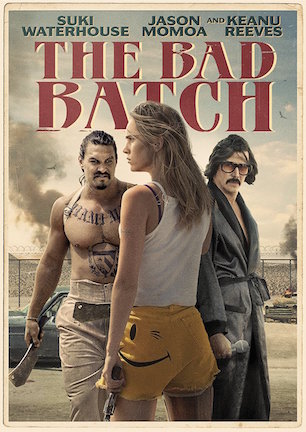Studio: Neon
Director: Ana Lily Amirpour
Writer: Ana Lily Amirpour
Producer: Danny Gabai, Sina Sayyah
Stars: Suki Waterhouse, Jason Momoa, Giovanni Ribisi, Yolonda Ross, Jayda Fink, Cory Roberts, Keanu Reeves, Jim Carrey
Review Score:
Summary:
An exiled woman escapes captivity in a dystopian wasteland where she unexpectedly connects to a stoic cannibal’s family.
Review:
Dismissed from her debt to society in a dystopian near future, Arlen is branded as one of the “bad batch” and banished to a desert populated by cannibals in one camp, discarded dreamers in another, and assorted scavengers wandering the wasteland in between. Caught by crazies almost immediately upon entry, Arlen pays a new debt of an arm and a leg when she is chained up as food outside a dirty old trailer.
Missing two limbs doesn’t diminish her resilience, however. Arlen eventually manages to brutally beat her captor before making an escape. Later, she ends up in Comfort, an oasis community where drifters, druggies, and other dregs from the bad batch survive in a sort of Skid Row overseen by a rock star prophet known as “The Dream.”
Five months later, Arlen continues to wander both physically and figuratively. Arlen’s ennui ultimately returns her to the dangers of the desert, driven by desire to confront any kind of inspiring challenge. She finds that challenge in the form of a people-eating family man whose quiet intensity is oddly alluring. Arlen now finds herself fighting to fit inside this weird world of misfits while struggling to make a connection, even if that connection is with a cannibal.
“The Bad Batch” is unquestionably an Ana Lily Amirpour joint from start to finish. Every fingerprint ridge that identifies Amirpour’s first film “A Girl Walks Home Alone at Night” (review here) as a unique vision leaves its oily print here too. This means expansive establishing shots held for long lengths of time, even longer bouts of wordless silence, and of course, a carefully curated throwback soundtrack, skateboards, retro props, and people identified by role or pronoun instead of actual names.
If “A Girl Walks Home Alone at Night” is unfamiliar to you, thus generating difficulty in grabbing an initial handle on “The Bad Batch,” the film’s artiness can be exemplified with a single scene. One moment finds Arlen alone in her room cutting paper dolls out of magazine models. She then tapes the shapely arm of one woman to the glass while aligning her amputated stump in the mirror, staring long at this artificial reflection of Frankenstein fantasy.
Maybe the metaphoric subtext involves Arlen’s dream of being the person she once was. Maybe it is a moment of reconciliation with reality weighed against wishes. Whatever the interpretation, Amirpour leaves it up to the individual to determine. So if this is the kind of thematic ambiguity you like spending your moviegoing time mulling over, then “The Bad Batch” is the kind of movie for you.
If that still isn’t framing the oblique experience in store, this bit of dialogue should wipe more mist from the mirror. Arlen wonders aloud at one point, “what if all the these things that happen to us, happen to us so that the next things that happen to us can happen to us?” It’s like a Diablo Cody character went full-on modern millennial in her musing, confusing a silly sentiment for something sounding poetically profound to someone who doesn’t know any better.
Two full hours is an excruciating term of time to spend immersed in this molasses-speed marathon of cryptic malaise. “The Bad Batch” pays zero attention to how long it takes to accomplish anything, laying a narrative frame of a disfigured outcast developing a new identity in the wake of a wasteland, then filling it in with punishing periods of inactivity.
Jim Carrey is incredibly unrecognizable as a mute hermit, though the underlying sense is that characters like his exist so prominent actors have a reason to play dress-up as derelicts. Giovanni Ribisi has three scenes as a mentally ill nomad. One features Ribisi thrusting his hips in mimicry of a street dog humping another pooch. Ribisi’s other brief inclusions have him unable to answer Arlen’s question about his ravings, and then shrugging his shoulders as no help in Arlen’s search for a missing child. As useless as he is to Arlen, Ribisi is more useless to the movie.
Keanu Reeves, outfitted to resemble a disco era porn star, delivers a mid-movie monologue about the bad batch being the not good enough, not smart enough flotsam no one wants. All we really see them do is mindlessly dance to rave music, drop acid, and fight about food scraps while longing for a life of pregnancy and assault rifles in Keanu’s luxurious estate. Maybe there’s meta-commentary here about mindless masses buying into commercialized idealisms. Or maybe everyone’s boring behavior inadvertently affirms civilization did the right thing by exiling pointlessness to somewhere out of sight and out of mind.
On one hand, it’s remarkable that writer/director Ana Lily Amirpour has established such a distinctive artistic voice after delivering only two feature films. On the other hand, it’s disappointing that both projects are so stylistically similar in technique, her sophomore effort doesn’t highlight any significant evolution in Amirpour’s cinematic vocabulary beyond what was already glimpsed in her widely praised debut.
After two outings, Amirpour’s disregard for rhythm through an aversion to editing is creating more tedium than introspective content. If her scripts don’t start applying her sensibilities to storytelling instead of primarily establishing arthouse atmosphere, there will only be less incentive to take a third tour through tone instead of a tangible tale.
Review Score: 50






It assumes everyone watching must be a dimwit too dense to understand how the most basic storytelling concepts work.